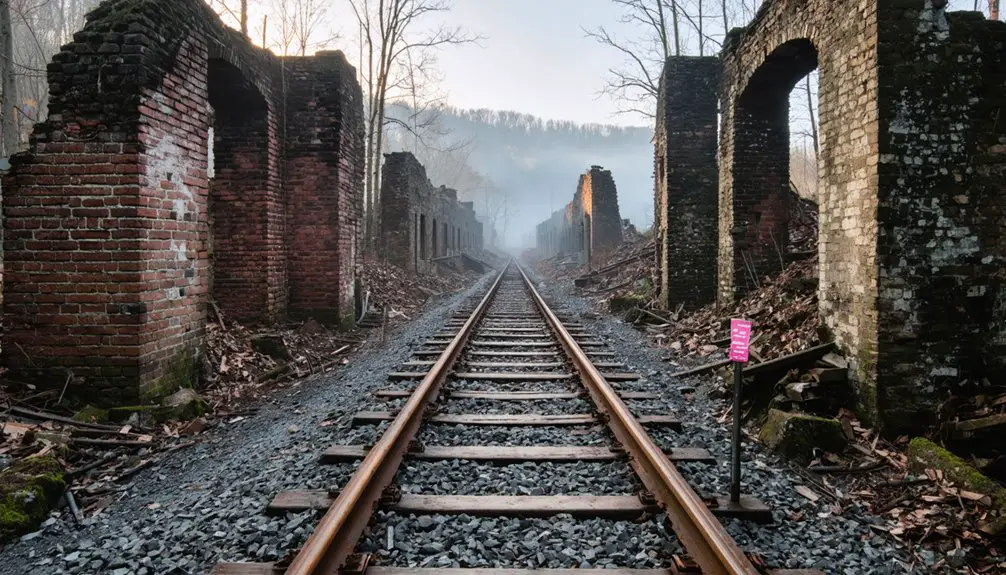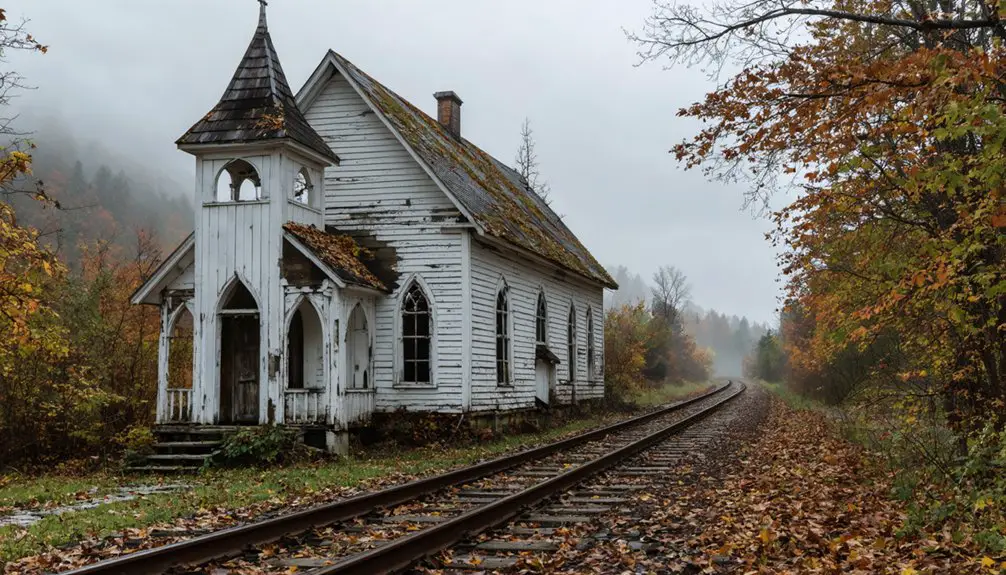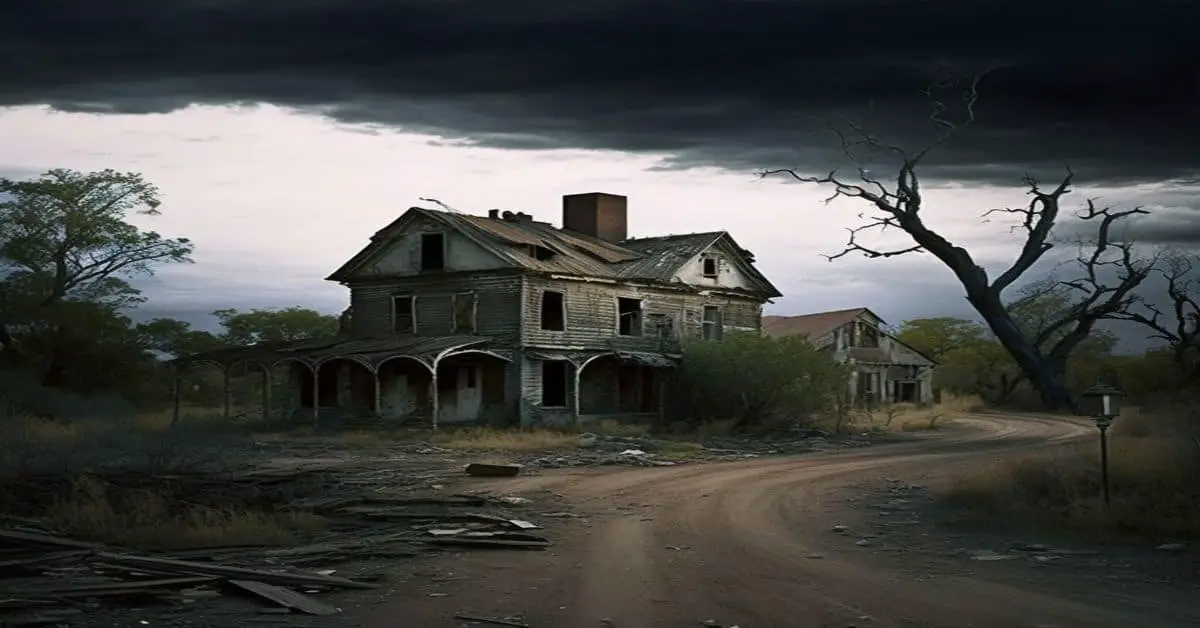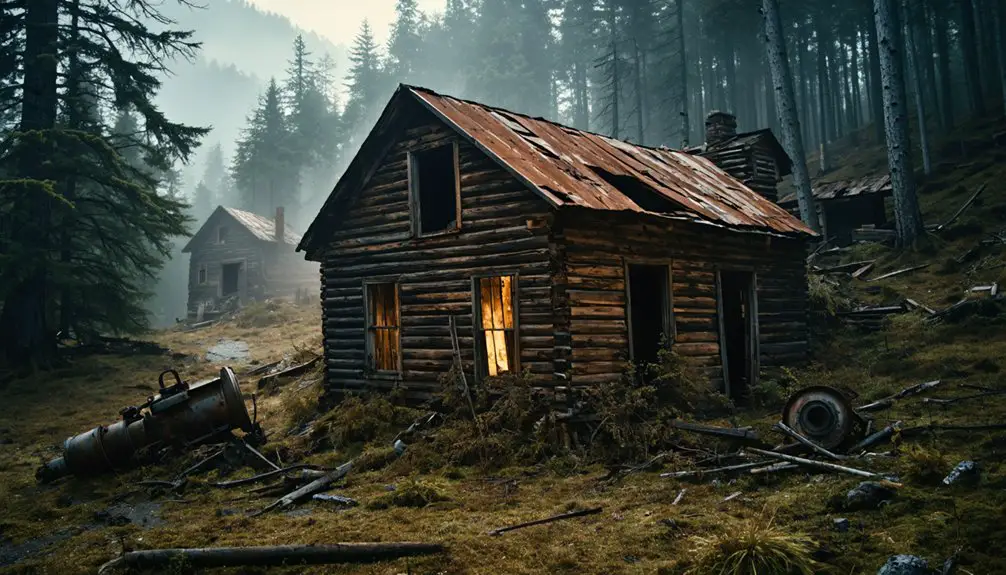You’ll find Kempton, Maryland’s ghost town nestled along the North Branch Potomac River, where a bustling coal mining community of 900 residents once thrived. Established in 1913 by Davis Coal and Coke Company, the town featured comfortable company houses, an Opera House, and Mine No. 42, which produced over a million tons of coal annually. When Compass Coal Company abruptly closed operations in 1950, the mine flooded within six months, leaving behind a remarkably preserved snapshot of Appalachian mining life.
Key Takeaways
- Kempton was established in 1913 as a coal mining town by Davis Coal and Coke Company along the North Branch Potomac River.
- The town flourished with 900 residents, company houses, an Opera House, and social amenities during its peak in the 1930s.
- Abrupt closure by Compass Coal Company in April 1950 led to mine flooding and rapid transformation into a ghost town.
- Archaeological findings and LIDAR surveys reveal preserved foundations and artifacts beneath overgrowth, documenting early 20th-century mining life.
- The site now faces environmental challenges from acid mine drainage, releasing one billion gallons of contaminated water annually.
The Birth of a Coal Company Town
When the Davis Coal and Coke Company established Kempton in 1913, they strategically chose a location along the North Branch Potomac River and West Virginia Central & Pittsburg Railway to service their new Mine No. 42.
They cleared a town site stretching 3/4 mile long and several hundred feet wide to accommodate their vision of a planned community.
The company’s infrastructure took shape as they targeted the rich Upper Freeport Seam, locally known as the Davis seam. By 1915, mining operations began under their subsidiary, Kempton Mine Company. The mine quickly became highly productive, reaching one million tons annually by 1915.
The Davis seam promised rich coal deposits, leading Kempton Mine Company to establish operations in 1915 under Davis Coal’s guidance.
Community planning centered on worker comfort, with 4-6 room houses featuring front yards and gardens arranged along two streets. The homes were affordable for miners with two dollar rent charged monthly.
You’d find essential amenities like a company store, school, opera house, and post office, creating a self-contained mining settlement that reflected the era’s integrated corporate approach.
Life in Kempton’s Golden Era
During Kempton’s peak years in the 1930s, nearly 900 residents enjoyed a quality of life that defied typical coal town stereotypes.
You’d find well-planned streets lined with comfortable 4-6 room company houses, each featuring front yards and vegetable gardens that promoted domestic stability. Workers could receive chinky tink scrip as cash advances for purchases at the store. The mine operator made deliberate efforts to create a model company town.
The town’s social life centered around key gathering spots that fostered strong community cohesion. You could spend your evenings at the Opera House, enjoying its bowling alley, pool table, and dance floor, or meet neighbors at the company store across the state line in West Virginia.
Children attended the local school, established in 1915, while adults balanced work with recreation. Despite environmental challenges from mining operations, residents maintained a structured yet vibrant community life, complete with quality domestic goods and regular social activities.
Mining Operations and Economic Impact
The Davis Coal & Coke Company launched Kempton’s mining era in 1914 with Mine No. 42, establishing one of Maryland’s most sophisticated coal operations of its time.
Mining technology advancements included modern machinery and dual-hoist systems reaching depths of 430 feet, while extensive underground networks stretched 7-8 miles.
You’d find efficient coal transportation logistics at work, with the Western Maryland Railroad spur facilitating daily shipments of 250-300 tons of high-quality, low-smoke coal to industrial centers like Maryland Steel Company.
The mine’s success transformed Kempton into a thriving community of 900 residents by the 1930s.
A tragic mine explosion in March 1916 claimed thirteen lives, highlighting the dangerous nature of coal mining work.
However, the sudden closure in 1950 devastated the local economy, despite remaining coal reserves.
The mine flooded within weeks, leaving behind a legacy of environmental challenges and a stark reminder of the region’s boom-and-bust mining history.
The town once boasted 106 company houses that accommodated its industrious mining workforce and their families.
The Sudden Decline and Abandonment
Following Mine No. 42’s abrupt closure by Compass Coal Company in mid-April 1950, Kempton’s fate as a thriving mining community was sealed.
Within six months, the mine flooded, triggering a devastating chain of economic decline that transformed this once-bustling town of 900 residents into a ghost town. Careful research was needed to distinguish this place name disambiguation from other locations called Kempton.
In just half a year, rising waters sealed Kempton’s doom, sweeping away livelihoods and leaving empty streets where 900 once lived.
- You’d have witnessed families desperately relocating as their primary source of income vanished overnight.
- You’d have seen the painful closure of the company store and school, unraveling the fabric of community life.
- You’d have watched the town’s infrastructure crumble as the tax base evaporated.
The community collapse was particularly harsh because Kempton’s company-controlled economy left no alternative industries.
The railroad’s abandonment further isolated the town, while acid mine drainage contaminated local waterways, making the area increasingly uninhabitable for those who tried to stay.
Environmental Legacy and Restoration Efforts
You’ll find the most severe environmental challenge in Kempton’s aftermath has been acid mine drainage, which releases roughly a billion gallons of contaminated water annually into the North Branch of the Potomac River watershed.
The construction of seepage barriers and implementation of water treatment systems have been critical steps in containing the toxic discharge, though permanent solutions remain elusive. Current testing reveals a highly acidic environment with pH levels 3.1-3.3, creating dangerous conditions for aquatic life.
While wetland recovery efforts have shown promising results through reforestation and stream restoration projects, earning multiple awards for excellence in reclamation, the ongoing battle against AMD continues to shape Kempton’s environmental legacy.
Acid Mine Drainage Impact
Since mining operations ceased in 1950, Kempton Mine No. 42 has discharged approximately one billion gallons of highly acidic mine drainage annually into Laurel Run, devastating local aquatic ecosystems and water quality.
You’ll find the impact of this environmental crisis extends far beyond Kempton’s borders, with AMD remediation efforts struggling to combat the continuous flow of metal-laden water.
The destruction of aquatic biodiversity has transformed once-thriving waterways into lifeless streams, where:
- Your historic trout and bass populations have virtually disappeared
- Your local watershed suffers from deadly acid slugs during rainfall
- Your river bottom is contaminated with toxic metal precipitates
The Maryland Department of Environment now battles this legacy through active treatment systems, but the challenge of restoring these waters to their natural state remains formidable.
Seepage Barrier Construction
To combat the devastating acid mine drainage from Kempton Mine No. 42, engineers constructed a groundbreaking seepage barrier in 2003 that fundamentally altered the site’s environmental trajectory.
The innovative design used coal combustion products (CCPs) and fly ash as the primary seepage barrier materials, effectively sealing the mine shaft to prevent clean groundwater from entering the abandoned tunnels below.
You’ll find the construction techniques were precisely calculated – workers injected CCP grout around the shaft’s perimeter, ensuring tight soil compaction and minimal water infiltration.
This economical solution not only sealed water pathways but also immobilized contaminants within the barrier matrix.
The project’s success has led to measurable improvements in Laurel Run’s water quality, though ongoing monitoring remains essential for maintaining the barrier’s effectiveness in protecting local watersheds.
Wetland Recovery Progress
While the Kempton area’s environmental recovery has been gradual, wetland restoration efforts in the Chesapeake Bay watershed have shown measurable progress, with 4,862 acres of wetlands gained between 2014 and 2024.
The restoration projects have incorporated natural stream channel design and innovative techniques to rebuild the area’s ecological health. A Chesapeake Bay Trust grant of $494,000 supported critical stream restoration work. Despite current progress, experts indicate the watershed is off course for meeting 2025 targets.
- You’ll find over 2,500 newly planted trees improving carbon capture and wildlife corridors
- You can witness the transformation of former agricultural lands into thriving wetland habitats
- You’re now part of a community that’s achieved 40.77% of its habitat enhancement goals
The Beaver Dam Creek project stands as a demonstration of successful wetland restoration, where 2,700 linear feet of stream and a 1.25-acre wetland have been revitalized through community-driven initiatives and strategic partnerships.
Archaeological Discoveries and Modern Significance

You’ll find that recent archaeological work at Kempton has uncovered household artifacts challenging long-held stereotypes of impoverished coal mining families.
Through LIDAR sensing and careful excavation of miners’ home sites, researchers have documented a rich material culture that includes varied domestic goods and personal possessions.
These findings help reconstruct a more accurate picture of daily life in early 20th-century Appalachian coal communities, where families maintained more complex and culturally diverse households than previously portrayed.
Material Culture Reveals Truth
Recent archaeological discoveries in Kempton have transformed our understanding of life in this Appalachian coal town. Material culture found during excavations challenges long-held stereotypes about poverty and living conditions.
You’ll find evidence of a community that owned possessions beyond basic necessities, suggesting more complex economic conditions than previously depicted.
- Household artifacts reveal families maintained dignified homes with personal belongings and gardens.
- LIDAR mapping shows well-planned neighborhoods with structured domestic spaces.
- Archaeological finds demonstrate residents weren’t merely exploited workers, but community members with meaningful lives.
Through careful examination of these remnants, you can see how Kempton’s inhabitants created homes and lives that defied the oversimplified historical narrative of impoverished coal miners.
Their material culture tells a story of resilience and community pride.
Challenging Appalachian Mining Stereotypes
Through decades of archaeological research and modern technology, Kempton’s true story has emerged to challenge common stereotypes about Appalachian mining communities.
You’ll find evidence of community resilience in the town’s stable population of nearly 900 residents who maintained local traditions through religious services, social halls, and self-sufficiency practices like keeping livestock.
Rather than a picture of destitution, LIDAR technology and archaeological excavations reveal a well-organized town with diverse amenities.
The company houses, while modest, supported families who earned healthy wages from a highly productive mine yielding up to 300 tons daily.
The community’s social fabric included movies, pool halls, and a company doctor, painting a more nuanced picture of life in these often misunderstood mining towns.
Archaeological Methods and Findings
Extensive archaeological work at Kempton has revealed a complex portrait of early 20th-century mining life through innovative survey techniques and material findings.
Using LIDAR remote sensing and detailed field surveys, archaeologists have uncovered foundations and structures hidden beneath years of overgrowth. Artifact analysis challenges traditional views of coal mining communities, showing households that maintained normal living standards rather than extreme poverty.
- You’ll discover evidence of vibrant community life through remnants of shared spaces like bowling alleys and an auditorium.
- You can trace the daily experiences of nearly 900 residents who called Kempton home during its 1930s peak.
- You’re witnessing how the town’s rapid abandonment in 1950 preserved a snapshot of authentic Appalachian mining life.
Archaeological techniques have transformed our understanding of this historic company town, proving that standardized housing didn’t mean standardized lives.
Frequently Asked Questions
Are Any of the Original Kempton Mine Workers or Their Descendants Still Alive?
You won’t find any original Kempton miners alive today, but their descendants likely exist. While Kempton history doesn’t track descendant stories actively, some families may have roots in nearby communities.
What Happened to the Opera House Building After the Town’s Abandonment?
You’ll find no clear record of the Opera House’s final fate after 1950. Despite its historical significance, the building likely deteriorated alongside other town structures during Kempton’s abandonment.
Can Visitors Legally Explore the Remaining Structures in Kempton Today?
With 70+ years of abandonment, you can’t legally explore the structures without permission. No clear exploration regulations exist, but visitor safety concerns and private property laws restrict unauthorized access.
Were There Any Major Mining Accidents During Kempton’s Operational Years?
You’ll find the deadliest mining hazard was the 1916 Kempton Mine explosion, one of the area’s worst historical accidents, which killed 15-16 miners and injured several others among 71 workers present.
What Items of Value Were Left Behind When Residents Quickly Abandoned Kempton?
You’d find abandoned artifacts of significant historical value: well-furnished homes with dishware and utensils, mining equipment, company store goods, personal belongings, and financial documents including company-issued scripts.
References
- http://allenbrowne.blogspot.com/2012/03/upper-potomac-ghost-town-in-southwest.html
- https://www.frostburg.edu/news/2019/09/ghost-town.php
- https://en.wikipedia.org/wiki/Kempton
- https://abandonedonline.net/location/kempton/
- http://www.mountaindiscoveries.com/stories/fw2002/heritagetrail_plain.html
- https://www.coalcampusa.com/nowv/potomac/kempton-md-coal-mine/kempton-md-coal-mine.htm
- https://kemptonarchaeology.com
- https://morningsonmaplestreet.com/2015/01/05/the-blizzard-family-kempton-maryland-john-vachon/
- https://en.wikipedia.org/wiki/List_of_ghost_towns_in_Maryland
- https://www.frostburg.edu/news/2019/09/the-long-dark-shadow-of-coal-acid-mine-drainage-in-kempton.php



